Fine-Resolution Mapping of Pan-Arctic Lake Ice-Off Phenology Based on Dense Sentinel-2 Time Series Data
Abstract
:1. Introduction
2. Materials and Methods
2.1. Study Area Boundaries and Lake Selection
2.2. Datasets
2.3. Lake Ice-Off Phenology Mapping Algorithm
2.3.1. Lake Extent Refinement
2.3.2. BUE Identification
- Creation of phenophase time series
- Outlier removal
- The “max-seg-difference” algorithm
2.3.3. Evaluation of Lake Ice-Off Phenology Mapping
2.3.4. Analysis Method
3. Results
3.1. Assessment of the Refined Lake Extent
3.2. Evaluation of Lake Ice-Off Phenology Mapping
3.3. Spatial Pattern of Pan-Arctic Lake Ice BUE
4. Discussion
5. Conclusions
Author Contributions
Funding
Data Availability Statement
Acknowledgments
Conflicts of Interest
References
- Paltan, H.; Dash, J.; Edwards, M. A Refined Mapping of Arctic Lakes Using Landsat Imagery. Int. J. Remote Sens. 2015, 36, 5970–5982. [Google Scholar] [CrossRef] [Green Version]
- Muster, S.; Roth, K.; Langer, M.; Lange, S.; Cresto Aleina, F.; Bartsch, A.; Morgenstern, A.; Grosse, G.; Jones, B.; Sannel, A.B.K.; et al. PeRL: A Circum-Arctic Permafrost Region Pond and Lake Database. Earth Syst. Sci. Data 2017, 9, 317–348. [Google Scholar] [CrossRef] [Green Version]
- Nitze, I.; Grosse, G.; Jones, B.M.; Romanovsky, V.E.; Boike, J. Remote Sensing Quantifies Widespread Abundance of Permafrost Region Disturbances across the Arctic and Subarctic. Nat. Commun. 2018, 9, 5423. [Google Scholar] [CrossRef]
- Olefeldt, D.; Hovemyr, M.; Kuhn, M.A.; Bastviken, D.; Bohn, T.J.; Connolly, J.; Crill, P.; Euskirchen, E.S.; Finkelstein, S.A.; Genet, H.; et al. The Boreal-Arctic Wetland and Lake Dataset (BAWLD). Earth Syst. Sci. Data Discuss. 2021, 2021, 1–40. [Google Scholar] [CrossRef]
- Cooley, S.W.; Smith, L.C.; Ryan, J.C.; Pitcher, L.H.; Pavelsky, T.M. Arctic-Boreal Lake Dynamics Revealed Using CubeSat Imagery. Geophys. Res. Lett. 2019, 46, 2111–2120. [Google Scholar] [CrossRef]
- Newton, A.M.W.; Mullan, D. Climate Change and Northern Hemisphere Lake and River Ice Phenology. Cryosphere Discuss. 2020, 2020, 1–60. [Google Scholar] [CrossRef]
- Surdu, C.M.; Duguay, C.R.; Fernández Prieto, D. Evidence of Recent Changes in the Ice Regime of Lakes in the Canadian High Arctic from Spaceborne Satellite Observations. Cryosphere 2016, 10, 941–960. [Google Scholar] [CrossRef] [Green Version]
- Weber, H.; Riffler, M.; Nõges, T.; Wunderle, S. Lake Ice Phenology from AVHRR Data for European Lakes: An Automated Two-Step Extraction Method. Remote Sens. Environ. 2016, 174, 329–340. [Google Scholar] [CrossRef]
- Zhang, S.; Pavelsky, T.M. Remote Sensing of Lake Ice Phenology across a Range of Lakes Sizes, ME, USA. Remote Sens. 2019, 11, 1718. [Google Scholar] [CrossRef] [Green Version]
- Cory, R.M.; Ward, C.P.; Crump, B.C.; Kling, G.W. Sunlight Controls Water Column Processing of Carbon in Arctic Fresh Waters. Science 2014, 345, 925. [Google Scholar] [CrossRef]
- Engram, M.; Anthony, K.W.; Meyer, F.J.; Grosse, G. Synthetic Aperture Radar (SAR) Backscatter Response from Methane Ebullition Bubbles Trapped by Thermokarst Lake Ice. Can. J. Remote Sens. 2013, 38, 667–682. [Google Scholar] [CrossRef]
- Engram, M.; Walter Anthony, K.M.; Sachs, T.; Kohnert, K.; Serafimovich, A.; Grosse, G.; Meyer, F.J. Remote Sensing Northern Lake Methane Ebullition. Nat. Clim. Chang. 2020, 10, 511–517. [Google Scholar] [CrossRef]
- Rey, D.M.; Walvoord, M.; Minsley, B.; Rover, J.; Singha, K. Investigating Lake-Area Dynamics across a Permafrost-Thaw Spectrum Using Airborne Electromagnetic Surveys and Remote Sensing Time-Series Data in Yukon Flats, Alaska. Environ. Res. Lett. 2019, 14, 025001. [Google Scholar] [CrossRef]
- Ruan, Y.; Zhang, X.; Xin, Q.; Qiu, Y.; Sun, Y. Prediction and Analysis of Lake Ice Phenology Dynamics Under Future Climate Scenarios Across the Inner Tibetan Plateau. J. Geophys. Res. Atmos. 2020, 125, e2020JD033082. [Google Scholar] [CrossRef]
- Dauginis, A.A.; Brown, L.C. Recent Changes in Pan-Arctic Sea Ice, Lake Ice, and Snow on/off Timing. Cryosphere Discuss. 2021, 2021, 1–35. [Google Scholar] [CrossRef]
- Brown, L.C.; Duguay, C.R. Modelling Lake Ice Phenology with an Examination of Satellite-Detected Subgrid Cell Variability. Adv. Meteorol. 2012, 2012, 529064. [Google Scholar] [CrossRef] [Green Version]
- Yang, X.; Pavelsky, T.M.; Allen, G.H. The Past and Future of Global River Ice. Nature 2020, 577, 69–73. [Google Scholar] [CrossRef]
- Duguay, C.R.; Bernier, M.; Gauthier, Y.; Kouraev, A. Remote sensing of lake and river ice. In Remote Sensing of the Cryosphere; John Wiley & Sons, Ltd.: Hoboken, NJ, USA, 2015; pp. 273–306. ISBN 978-1-118-36890-9. [Google Scholar]
- Che, T.; Li, X.; Jin, R. Monitoring the Frozen Duration of Qinghai Lake Using Satellite Passive Microwave Remote Sensing Low Frequency Data. Chin. Sci. Bull. 2009, 54, 2294–2299. [Google Scholar] [CrossRef]
- Kang, K.-K.; Duguay, C.R.; Howell, S.E.L. Estimating Ice Phenology on Large Northern Lakes from AMSR-E: Algorithm Development and Application to Great Bear Lake and Great Slave Lake, Canada. Cryosphere 2012, 6, 235–254. [Google Scholar] [CrossRef] [Green Version]
- Xiong, C.; Lei, Y.; Qiu, Y. Contrasting Lake Ice Phenology Changes in the Qinghai-Tibet Plateau Revealed by Remote Sensing. IEEE Geosci. Remote Sens. Lett. 2020, 1–5. [Google Scholar] [CrossRef]
- Murfitt, J.; Duguay, C.R. Assessing the Performance of Methods for Monitoring Ice Phenology of the World’s Largest High Arctic Lake Using High-Density Time Series Analysis of Sentinel-1 Data. Remote Sens. 2020, 12, 382. [Google Scholar] [CrossRef] [Green Version]
- Yang, Q.; Song, K.; Wen, Z.; Hao, X.; Fang, C. Recent Trends of Ice Phenology for Eight Large Lakes Using MODIS Products in Northeast China. Int. J. Remote Sens. 2019, 40, 5388–5410. [Google Scholar] [CrossRef]
- Šmejkalová, T.; Edwards, M.E.; Dash, J. Arctic Lakes Show Strong Decadal Trend in Earlier Spring Ice-Out. Sci. Rep. 2016, 6, 38449. [Google Scholar] [CrossRef] [PubMed]
- Sharma, S.; Meyer, M.F.; Culpepper, J.; Yang, X.; Hampton, S.; Berger, S.A.; Brousil, M.R.; Fradkin, S.C.; Higgins, S.N.; Jankowski, K.J.; et al. Integrating Perspectives to Understand Lake Ice Dynamics in a Changing World. J. Geophys. Res. Biogeosci. 2020, 125, e2020JG005799. [Google Scholar] [CrossRef]
- Scott, K.A.; Xu, L.; Pour, H.K. Retrieval of Ice/Water Observations from Synthetic Aperture Radar Imagery for Use in Lake Ice Data Assimilation. J. Gt. Lakes Res. 2020, 46, 1521–1532. [Google Scholar] [CrossRef]
- Mishra, V.; Cherkauer, K.A.; Bowling, L.C.; Huber, M. Lake Ice Phenology of Small Lakes: Impacts of Climate Variability in the Great Lakes Region. Glob. Planet. Chang. 2011, 76, 166–185. [Google Scholar] [CrossRef]
- Walker, D.A.; Reynolds, M.K.; Daniëls, F.J.A.; Einarsson, E.; Elvebakk, A.; Gould, W.A.; Katenin, A.E.; Kholod, S.S.; Markon, C.J.; Melnikov, E.S.; et al. The Circumpolar Arctic Vegetation Map. J. Veg. Sci. 2005, 16, 267–282. [Google Scholar] [CrossRef]
- Raynolds, M.K.; Walker, D.A.; Balser, A.; Bay, C.; Campbell, M.; Cherosov, M.M.; Daniëls, F.J.A.; Eidesen, P.B.; Ermokhina, K.A.; Frost, G.V.; et al. A Raster Version of the Circumpolar Arctic Vegetation Map (CAVM). Remote Sens. Environ. 2019, 232, 111297. [Google Scholar] [CrossRef]
- Messager, M.L.; Lehner, B.; Grill, G.; Nedeva, I.; Schmitt, O. Estimating the Volume and Age of Water Stored in Global Lakes Using a Geo-Statistical Approach. Nat. Commun. 2016, 7, 13603. [Google Scholar] [CrossRef]
- Liang, Y.-L.; Colgan, W.; Lv, Q.; Steffen, K.; Abdalati, W.; Stroeve, J.; Gallaher, D.; Bayou, N. A Decadal Investigation of Supraglacial Lakes in West Greenland Using a Fully Automatic Detection and Tracking Algorithm. Remote Sens. Environ. 2012, 123, 127–138. [Google Scholar] [CrossRef] [Green Version]
- Gorelick, N.; Hancher, M.; Dixon, M.; Ilyushchenko, S.; Thau, D.; Moore, R. Google Earth Engine: Planetary-Scale Geospatial Analysis for Everyone. Big Remote. Sensed Data Tools Appl. Exp. 2017, 202, 18–27. [Google Scholar] [CrossRef]
- Louis, J.; Pflug, B.; Main-Knorn, M.; Debaecker, V.; Mueller-Wilm, U.; Iannone, R.Q.; Cadau, E.G.; Boccia, V.; Gascon, F. Sentinel-2 Global Surface Reflectance Level-2a Product Generated with Sen2Cor. In Proceedings of the IGARSS 2019—2019 IEEE International Geoscience and Remote Sensing Symposium, Yokohama, Japan, 28 July–2 August 2019; pp. 8522–8525. [Google Scholar]
- Smith, L.C.; Sheng, Y.; MacDonald, G.M.; Hinzman, L.D. Disappearing Arctic Lakes. Science 2005, 308, 1429. [Google Scholar] [CrossRef] [Green Version]
- Pickens, A.H.; Hansen, M.C.; Hancher, M.; Stehman, S.V.; Tyukavina, A.; Potapov, P.; Marroquin, B.; Sherani, Z. Mapping and Sampling to Characterize Global Inland Water Dynamics from 1999 to 2018 with Full Landsat Time-Series. Remote Sens. Environ. 2020, 243, 111792. [Google Scholar] [CrossRef]
- Dong, J.; Xiao, X.; Menarguez, M.A.; Zhang, G.; Qin, Y.; Thau, D.; Biradar, C.; Moore, B., III. Mapping Paddy Rice Planting Area in Northeastern Asia with Landsat 8 Images, Phenology-Based Algorithm and Google Earth Engine. Remote Sens. Environ. 2016, 185, 142–154. [Google Scholar] [CrossRef] [Green Version]
- Chen, B.; Xiao, X.; Li, X.; Pan, L.; Doughty, R.; Ma, J.; Dong, J.; Qin, Y.; Zhao, B.; Wu, Z.; et al. A Mangrove Forest Map of China in 2015: Analysis of Time Series Landsat 7/8 and Sentinel-1A Imagery in Google Earth Engine Cloud Computing Platform. ISPRS J. Photogramm. Remote Sens. 2017, 131, 104–120. [Google Scholar] [CrossRef]
- Raiyani, K.; Gonçalves, T.; Rato, L.; Salgueiro, P.; Marques da Silva, J.R. Sentinel-2 Image Scene Classification: A Comparison between Sen2Cor and a Machine Learning Approach. Remote Sens. 2021, 13, 300. [Google Scholar] [CrossRef]
- Zhu, Z.; Zhang, J.; Yang, Z.; Aljaddani, A.H.; Cohen, W.B.; Qiu, S.; Zhou, C. Continuous Monitoring of Land Disturbance Based on Landsat Time Series. Time Ser. Anal. High Spat. Resolut. Imag. 2020, 238, 111116. [Google Scholar] [CrossRef]
- Arp, C.D.; Jones, B.M.; Grosse, G. Recent Lake Ice-out Phenology within and among Lake Districts of Alaska, U.S.A. Limnol. Oceanogr. 2013, 58, 2013–2028. [Google Scholar] [CrossRef]
- Liu, C.; Zhang, Q.; Tao, S.; Qi, J.; Ding, M.; Guan, Q.; Wu, B.; Zhang, M.; Nabil, M.; Tian, F.; et al. A New Framework to Map Fine Resolution Cropping Intensity across the Globe: Algorithm, Validation, and Implication. Remote Sens. Environ. 2020, 251, 112095. [Google Scholar] [CrossRef]
- Duguay, C.R.; Prowse, T.D.; Bonsal, B.R.; Brown, R.D.; Lacroix, M.P.; Ménard, P. Recent Trends in Canadian Lake Ice Cover. Hydrol. Process. 2006, 20, 781–801. [Google Scholar] [CrossRef]
- Du, J.; Kimball, J.S.; Duguay, C.; Kim, Y.; Watts, J.D. Satellite Microwave Assessment of Northern Hemisphere Lake Ice Phenology from 2002 to 2015. Cryosphere 2017, 11, 47–63. [Google Scholar] [CrossRef] [Green Version]
- Liu, C.; Zhang, Q.; Luo, H.; Qi, S.; Tao, S.; Xu, H.; Yao, Y. An Efficient Approach to Capture Continuous Impervious Surface Dynamics Using Spatial-Temporal Rules and Dense Landsat Time Series Stacks. Remote Sens. Environ. 2019, 229, 114–132. [Google Scholar] [CrossRef]
- Kirillin, G.; Leppäranta, M.; Terzhevik, A.; Granin, N.; Bernhardt, J.; Engelhardt, C.; Efremova, T.; Golosov, S.; Palshin, N.; Sherstyankin, P.; et al. Physics of Seasonally Ice-Covered Lakes: A Review. Aquat. Sci. 2012, 74, 659–682. [Google Scholar] [CrossRef]
- Williams, G.; Layman, K.L.; Stefan, H.G. Dependence of Lake Ice Covers on Climatic, Geographic and Bathymetric Variables. Cold Reg. Sci. Technol. 2004, 40, 145–164. [Google Scholar] [CrossRef]
- Magee, M.R.; Wu, C.H. Effects of Changing Climate on Ice Cover in Three Morphometrically Different Lakes. Hydrol. Process. 2017, 31, 308–323. [Google Scholar] [CrossRef]
- Beltaos, S.; Prowse, T. River-Ice Hydrology in a Shrinking Cryosphere. Hydrol. Process. 2009, 23, 122–144. [Google Scholar] [CrossRef]
- Cooley, S.W.; Smith, L.C.; Stepan, L.; Mascaro, J. Tracking Dynamic Northern Surface Water Changes with High-Frequency Planet CubeSat Imagery. Remote Sens. 2017, 9, 1306. [Google Scholar] [CrossRef] [Green Version]
- Sharma, S.; Blagrave, K.; Magnuson, J.J.; O’Reilly, C.M.; Oliver, S.; Batt, R.D.; Magee, M.R.; Straile, D.; Weyhenmeyer, G.A.; Winslow, L.; et al. Widespread loss of lake ice around the Northern Hemisphere in a warming world. Nat. Clim. Chang. 2019, 9, 227–231. [Google Scholar] [CrossRef]

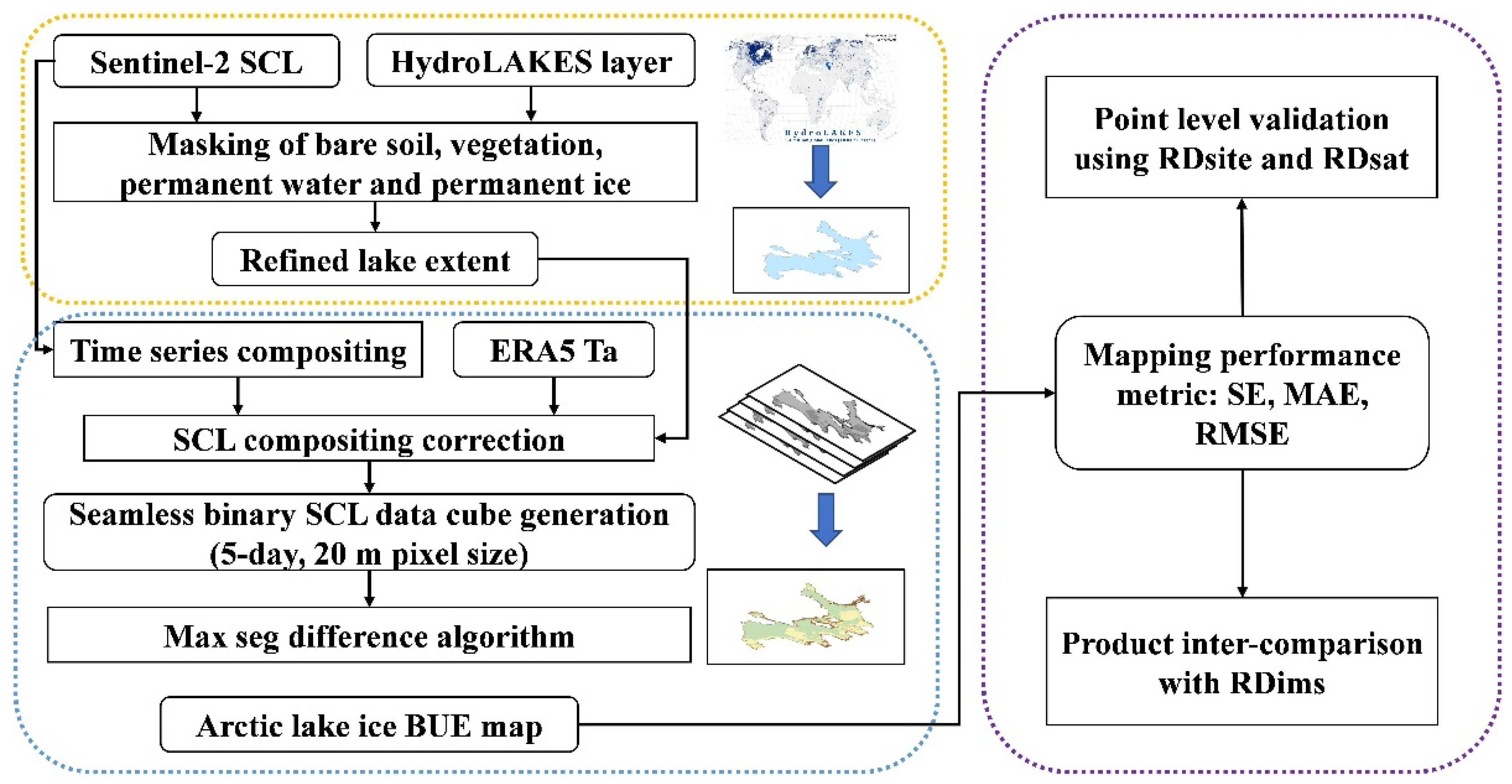
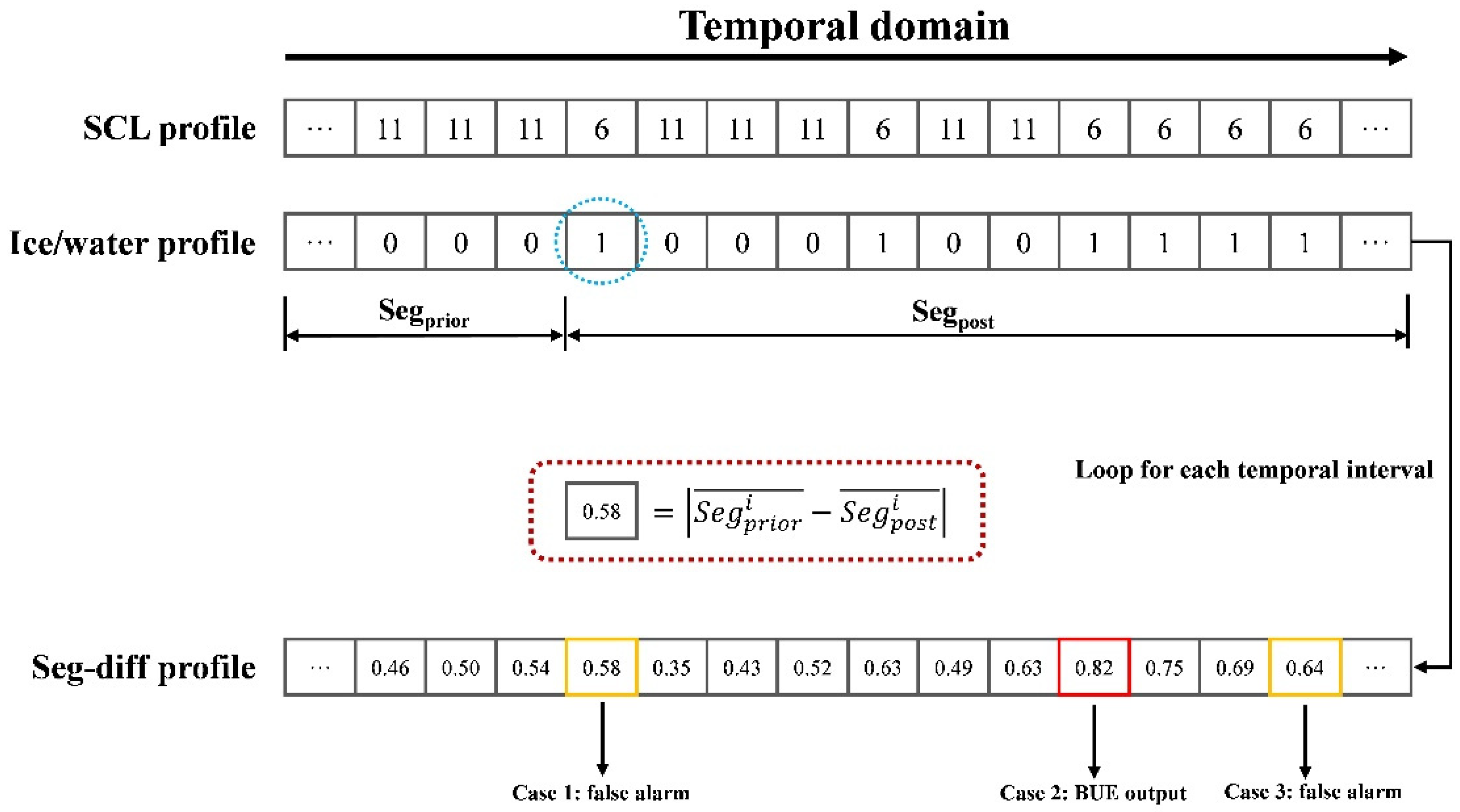
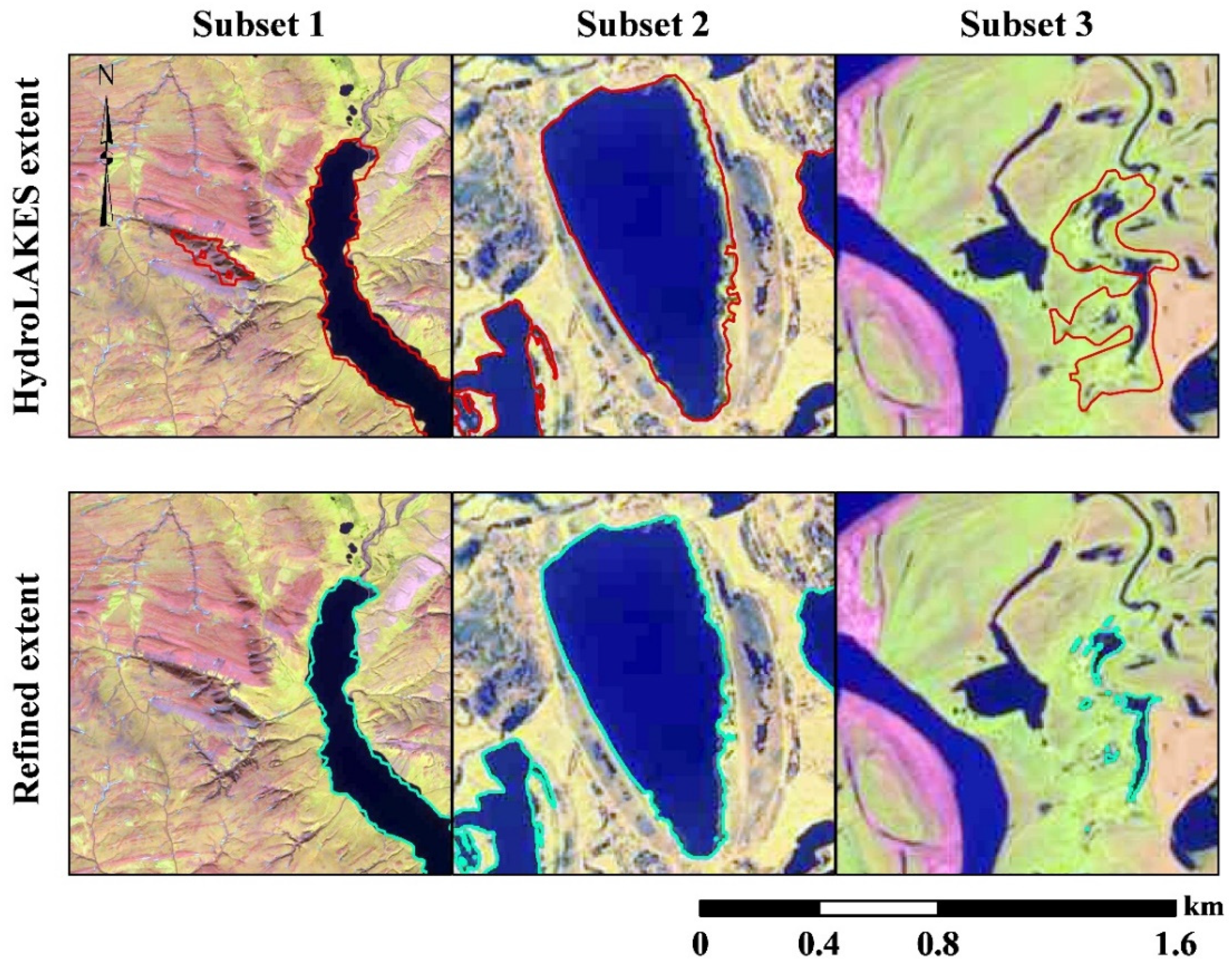
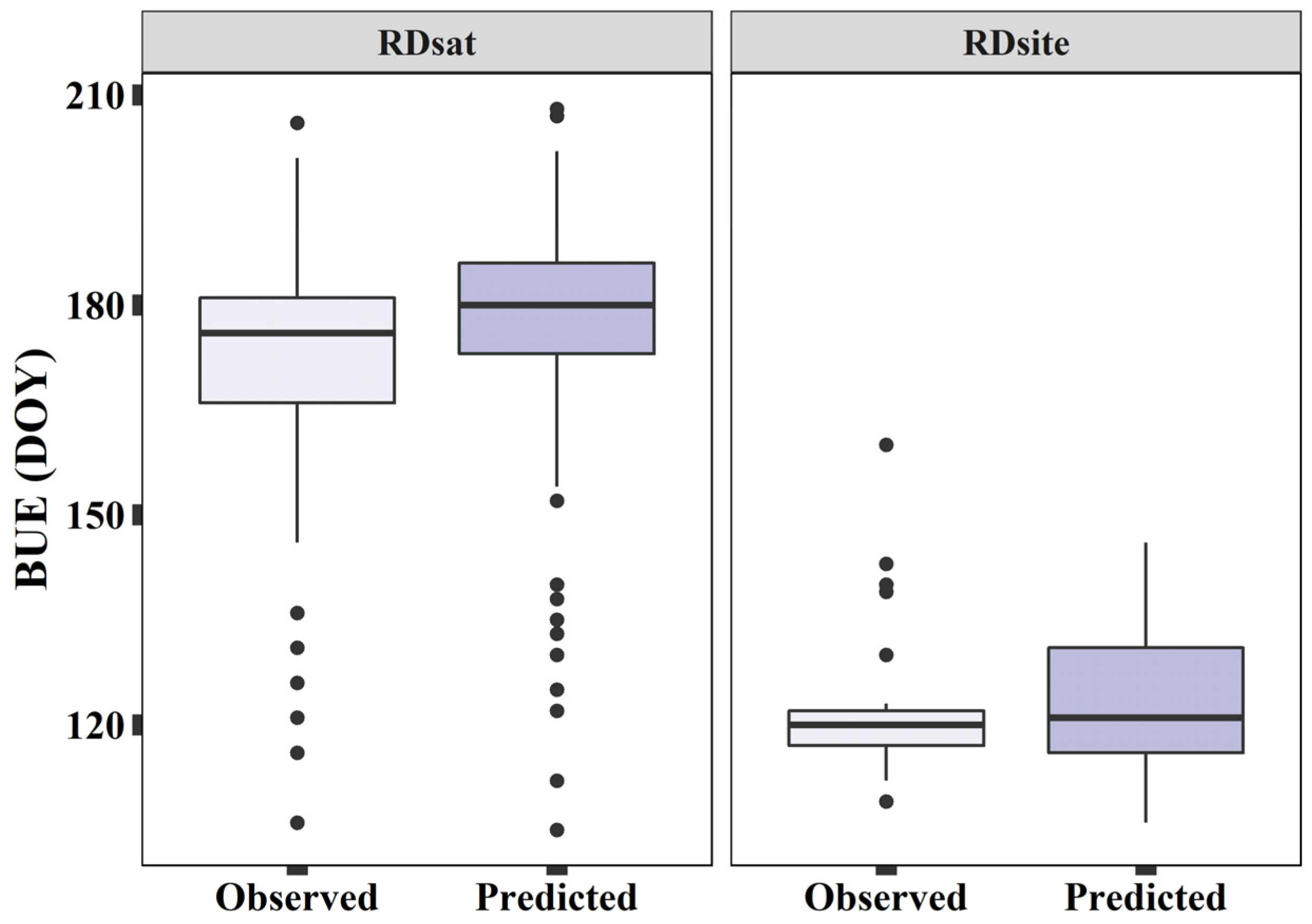
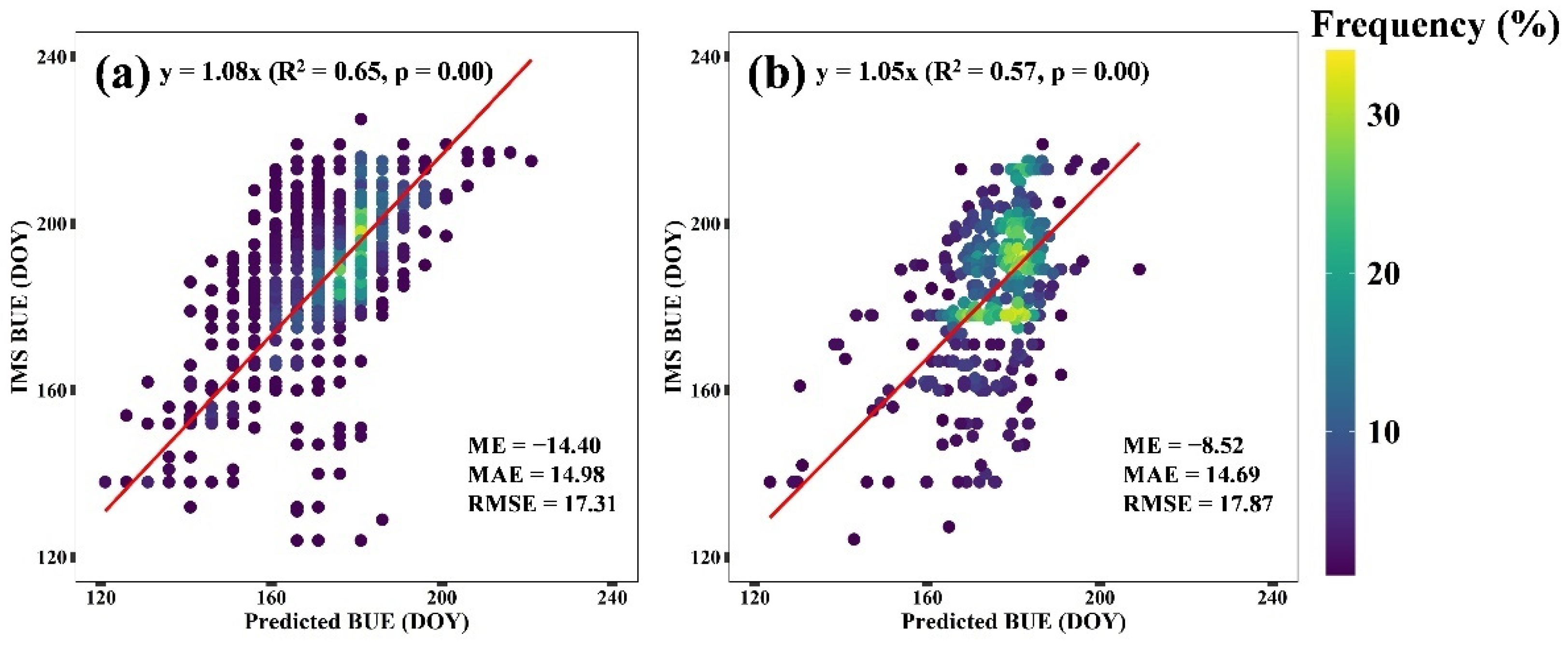
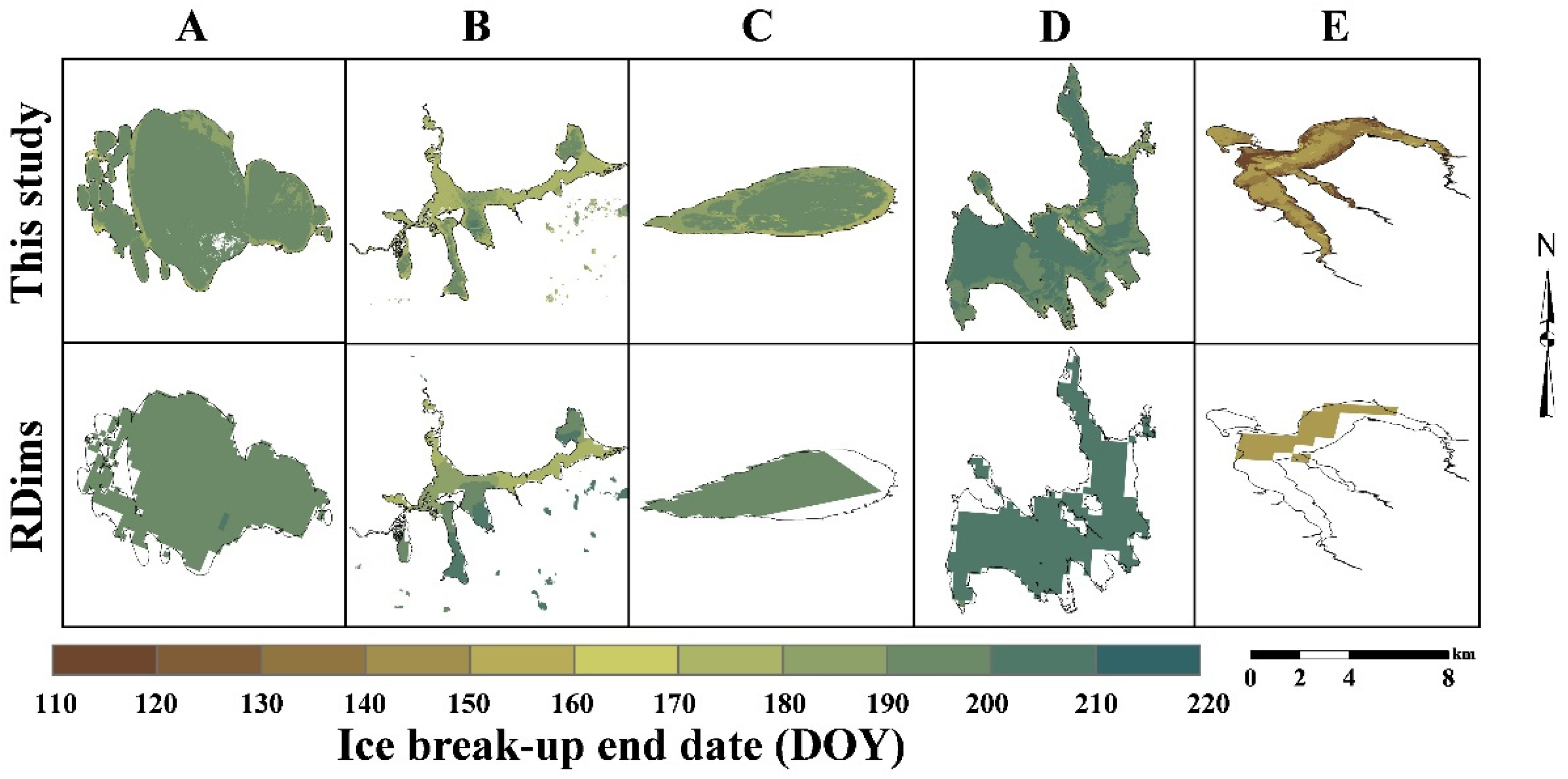
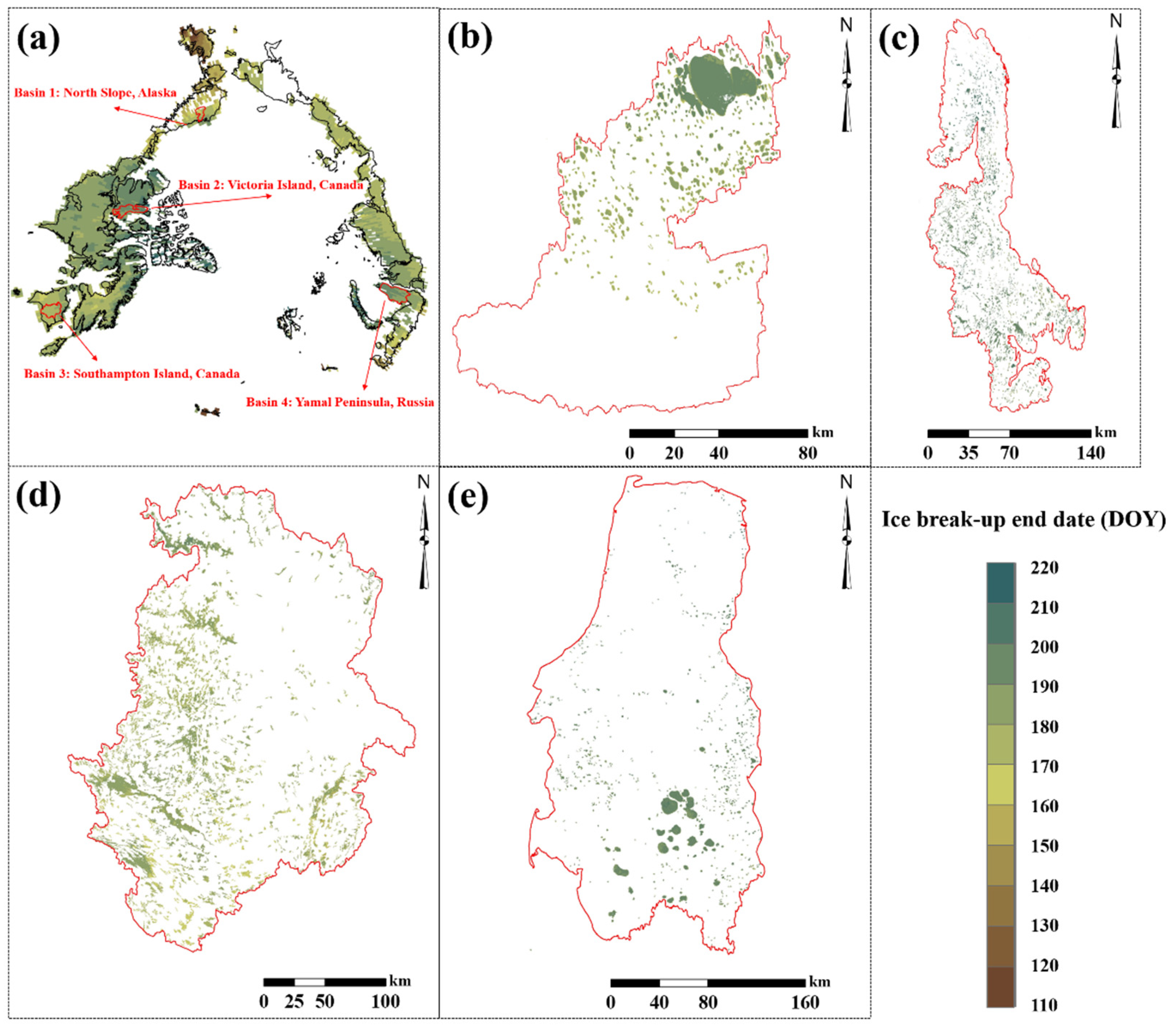
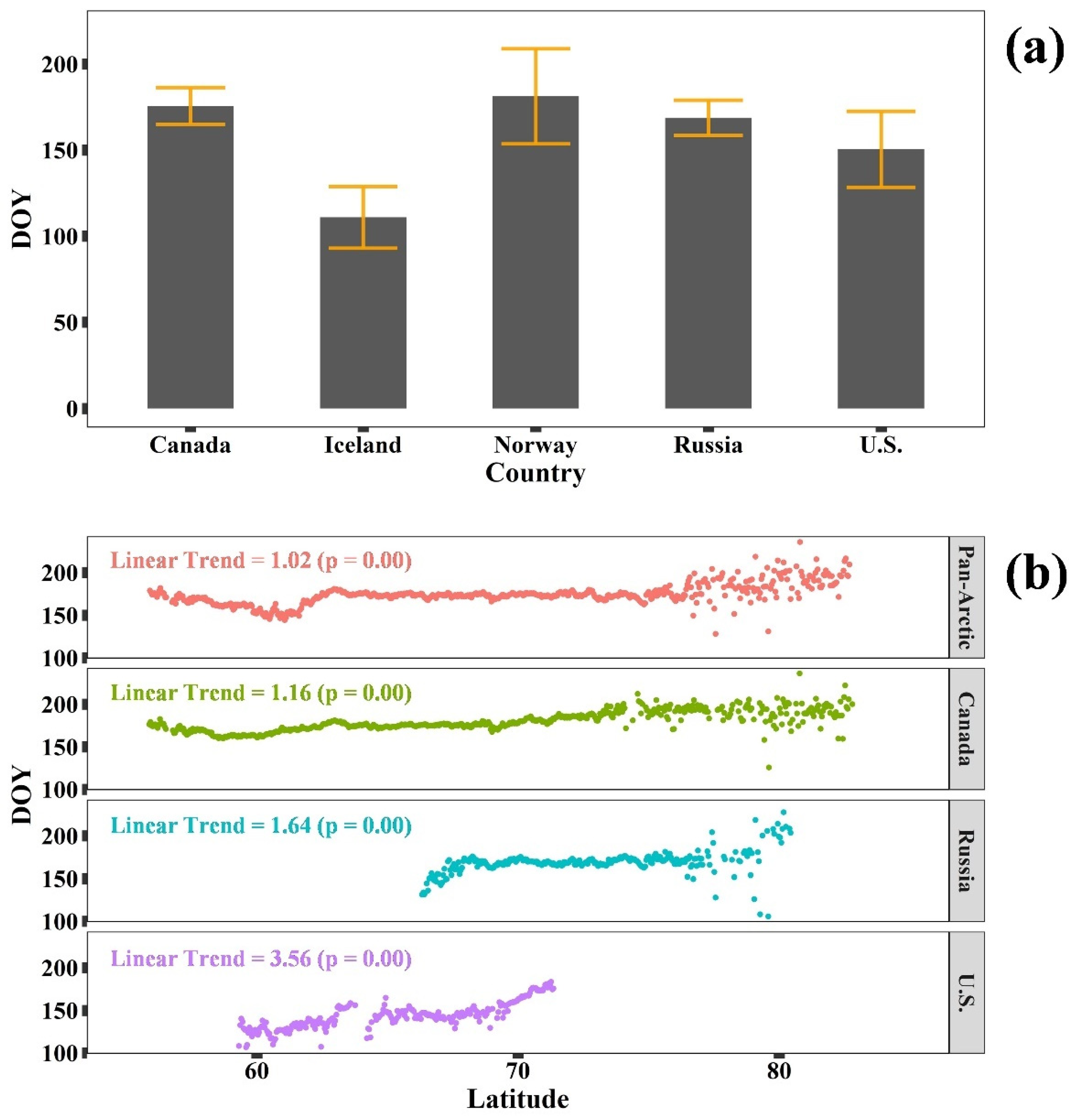
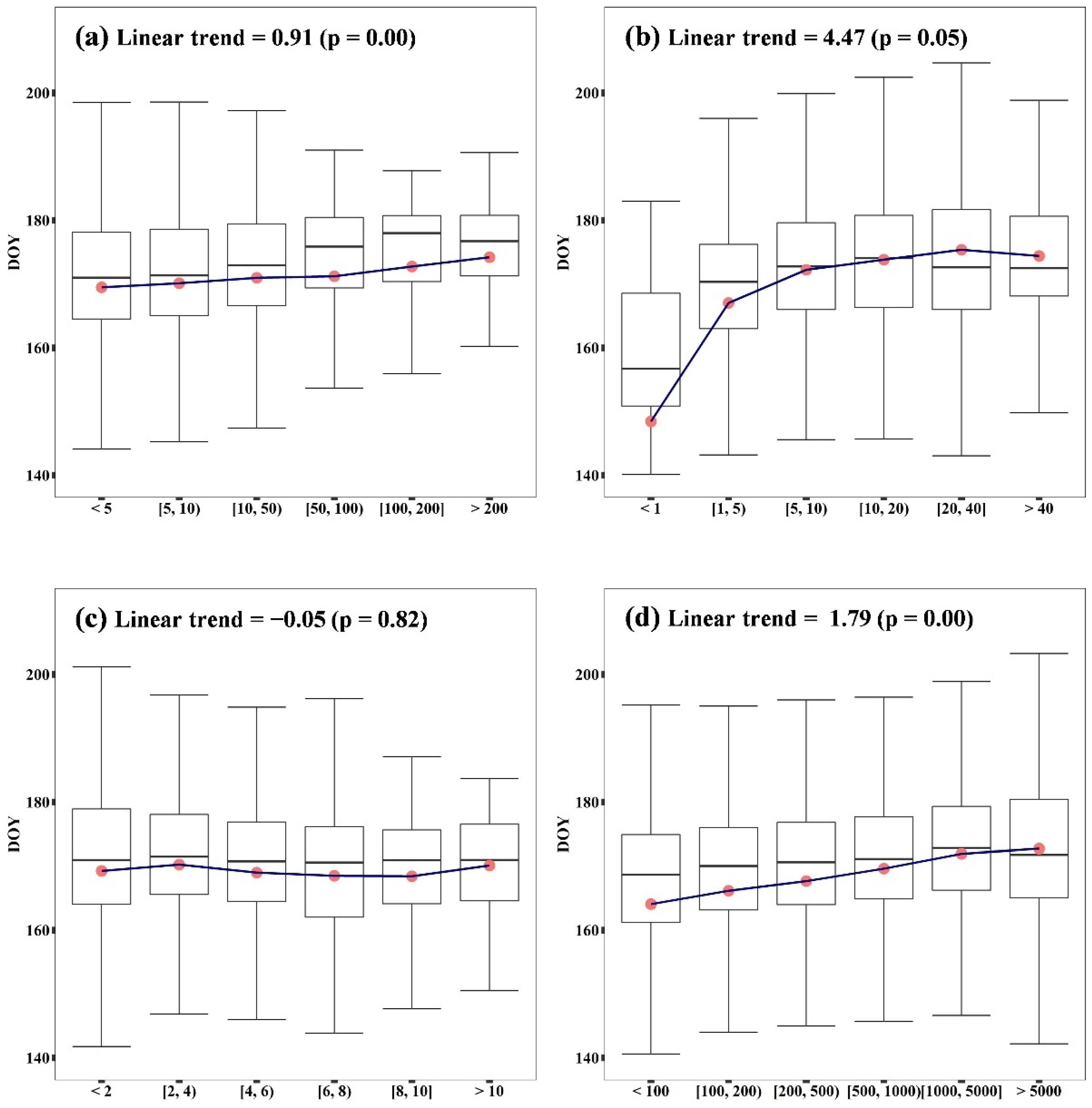
| Region | Commission (%) | Omission (%) | F1 Score (%) | Refined Lake Number | Refined Lake Area (km2) |
|---|---|---|---|---|---|
| Canada | 17.3 | 5.3 | 88.3 | 30,325 | 100,938 |
| Iceland | 1.3 | 4.0 | 97.3 | 8 | 6 |
| Norway | 2.7 | 6.7 | 95.3 | 57 | 43 |
| Russia | 5.3 | 12.0 | 91.2 | 11,495 | 27,841 |
| USA | 8.0 | 4.2 | 93.9 | 3647 | 9905 |
| Pan-Arctic | 6.7 | 6.8 | 93.2 | 45,532 | 138,733 |
| Number of Observations | ME | MAE | RMSE | |
|---|---|---|---|---|
| RDsite | 29 | 0.34 | 6.55 | 7.40 |
| RDsat | 234 | 6.14 | 7.79 | 9.92 |
Publisher’s Note: MDPI stays neutral with regard to jurisdictional claims in published maps and institutional affiliations. |
© 2021 by the authors. Licensee MDPI, Basel, Switzerland. This article is an open access article distributed under the terms and conditions of the Creative Commons Attribution (CC BY) license (https://creativecommons.org/licenses/by/4.0/).
Share and Cite
Liu, C.; Huang, H.; Hui, F.; Zhang, Z.; Cheng, X. Fine-Resolution Mapping of Pan-Arctic Lake Ice-Off Phenology Based on Dense Sentinel-2 Time Series Data. Remote Sens. 2021, 13, 2742. https://doi.org/10.3390/rs13142742
Liu C, Huang H, Hui F, Zhang Z, Cheng X. Fine-Resolution Mapping of Pan-Arctic Lake Ice-Off Phenology Based on Dense Sentinel-2 Time Series Data. Remote Sensing. 2021; 13(14):2742. https://doi.org/10.3390/rs13142742
Chicago/Turabian StyleLiu, Chong, Huabing Huang, Fengming Hui, Ziqian Zhang, and Xiao Cheng. 2021. "Fine-Resolution Mapping of Pan-Arctic Lake Ice-Off Phenology Based on Dense Sentinel-2 Time Series Data" Remote Sensing 13, no. 14: 2742. https://doi.org/10.3390/rs13142742
APA StyleLiu, C., Huang, H., Hui, F., Zhang, Z., & Cheng, X. (2021). Fine-Resolution Mapping of Pan-Arctic Lake Ice-Off Phenology Based on Dense Sentinel-2 Time Series Data. Remote Sensing, 13(14), 2742. https://doi.org/10.3390/rs13142742






